心理学概论第六章记忆
- 格式:pdf
- 大小:29.16 KB
- 文档页数:4


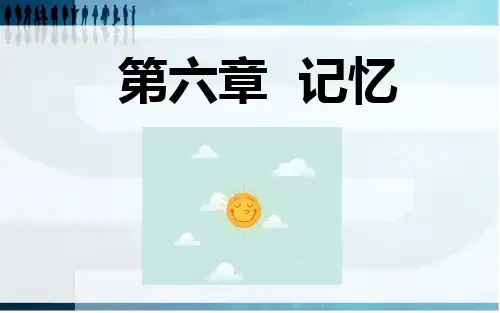
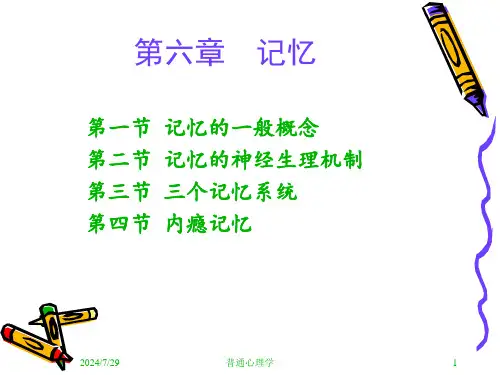
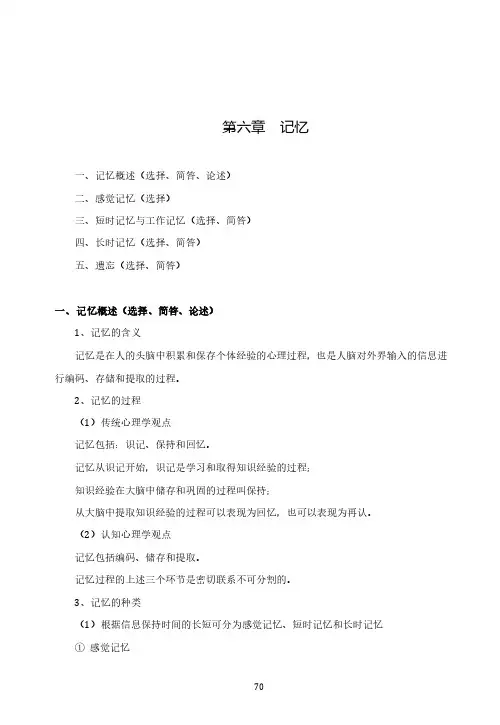
第六章记忆一、记忆概述(选择、简答、论述)二、感觉记忆(选择)三、短时记忆与工作记忆(选择、简答)四、长时记忆(选择、简答)五、遗忘(选择、简答)一、记忆概述(选择、简答、论述)1、记忆的含义记忆是在人的头脑中积累和保存个体经验的心理过程,也是人脑对外界输入的信息进行编码、存储和提取的过程。
2、记忆的过程(1)传统心理学观点记忆包括:识记、保持和回忆。
记忆从识记开始,识记是学习和取得知识经验的过程;知识经验在大脑中储存和巩固的过程叫保持;从大脑中提取知识经验的过程可以表现为回忆,也可以表现为再认。
(2)认知心理学观点记忆包括编码、储存和提取。
记忆过程的上述三个环节是密切联系不可分割的。
3、记忆的种类(1)根据信息保持时间的长短可分为感觉记忆、短时记忆和长时记忆①感觉记忆当客观刺激停止作用以后,感觉信息在一个极短的时间内被保存下来的记忆。
储存时间大约为0.25秒~2秒。
②短时记忆是感觉记忆和长时记忆的中间阶段,保持时间大约为5秒-1分钟,它的容量有限,大约为7±2个单位。
③长时记忆是指信息经过充分和有一定深度加工后,在头脑中长时间保存下来。
储存时间很长,从一分钟以上到甚至终生。
容量没有限制。
(2)图尔文按照长时记忆储存的内容分为情景记忆和语义记忆①情景记忆自己亲身经历过的,有时间、地点和情节的事件的记忆。
受一定的时间和空间的限制,容易受到干扰,记忆不够稳定。
②语义记忆又叫语词—逻辑记忆,是用语词概括的各种有组织的知识的记忆。
不易受到各种因素的干扰,比较稳定,提取也比较容易。
(3)按照提取时是否需要意识参与可分为内隐记忆和外显记忆①内隐记忆内隐记忆是个体并没有意识到,过去的经验却对当前的活动产生了影响,又叫自动的、无意识的记忆。
②外显记忆外显记忆是在意识的控制下,过去经验对当前作业产生的有意识的影响,又称受意识控制的记忆。
内隐记忆和外显记忆的表现有以下差别:①加工深度对刺激项目的加工深度并不影响内隐记忆,却对外显记忆有明显的影响。

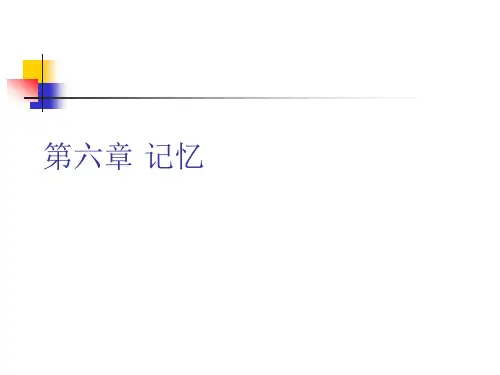
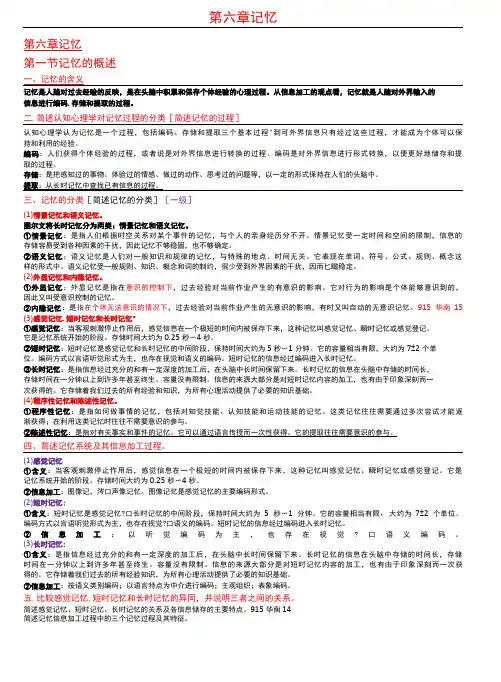
第六章记忆第六章记忆第一节记忆的概述一、记忆的含义记忆是人脑对过去经睑的反映,是在头脑中积累和保存个体经验的心理过程。
从信息加工的观点看,记忆就是人脑对外界输入的信息进行编码.存储和提取的过程。
二.简述认知心理学对记忆过程的分类[简述记忆的过程]认知心理学认为记忆是一个过程,包括编码、存储和提取三个基本过程"到可外界信息只有经过这些过程,才能成为个体可以保持和利用的经验。
编码:人们获得个体经验的过程,或者说是对外界信息进行转换的过程。
编码是对外界信息进行形式转换,以便更好地储存和提取的过程。
存储:是把感知过的事物、体验过的情感、做过的动作、思考过的问题等,以一定的形式保持在人们的头脑中。
提取:从长时记忆中查找已有信息的过程。
三、记忆的分类[简述记忆的分类][一级](1)情景记忆和语义记忆。
图尔文将长时记忆分为两类:情景记忆和语义记忆。
①情景记忆:是指人们根据时空关系对某个事件的记忆,与个人的亲身经历分不开。
情景记忆受一定时间和空间的限制,信息的存储容易受到各种因素的干扰,因此记忆不够稳固,也不够确定。
②语义记忆:语义记忆是人们对一般知识和规律的记忆,与特殊的地点、时间无关。
它表现在单词、符号、公式、规则、概念这样的形式中。
语义记忆受一般规则、知识、概念和词的制约,很少受到外界因素的干扰,因而匕瞰稳定。
(2)外显记忆和内隐记忆。
①外显记忆:外显记忆是指在意识的控制下,过去经验对当前作业产生的有意识的影响。
它对行为的影响是个体能够意识到的,因此又叫受意识控制的记忆。
②内隐记忆:是指在个体无法意识的情况下,过去经验对当前作业产生的无意识的影响,有时又叫自动的无意识记忆。
915华南15(3)感觉记忆.短时记忆和长时记忆°①感觉记忆:当客观刺激停止作用后,感觉信息在一个极短的时间内被保存下来,这种记忆叫感觉记忆、瞬时记忆或感觉登记。
它是记忆系统开始的阶段。
存储时间大约为0.25秒〜4秒。

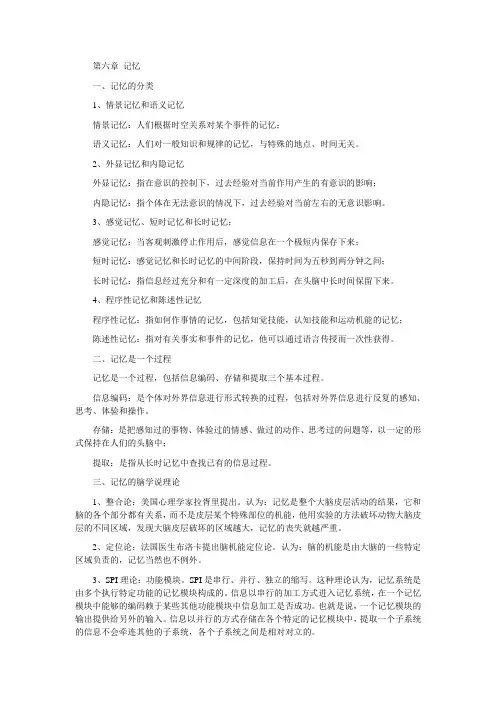
第六章记忆一、记忆的分类1、情景记忆和语义记忆情景记忆:人们根据时空关系对某个事件的记忆;语义记忆:人们对一般知识和规律的记忆,与特殊的地点、时间无关。
2、外显记忆和内隐记忆外显记忆:指在意识的控制下,过去经验对当前作用产生的有意识的影响;内隐记忆:指个体在无法意识的情况下,过去经验对当前左右的无意识影响。
3、感觉记忆、短时记忆和长时记忆;感觉记忆:当客观刺激停止作用后,感觉信息在一个极短内保存下来;短时记忆:感觉记忆和长时记忆的中间阶段,保持时间为五秒到两分钟之间;长时记忆:指信息经过充分和有一定深度的加工后,在头脑中长时间保留下来。
4、程序性记忆和陈述性记忆程序性记忆:指如何作事情的记忆,包括知觉技能,认知技能和运动机能的记忆;陈述性记忆:指对有关事实和事件的记忆,他可以通过语言传授而一次性获得。
二、记忆是一个过程记忆是一个过程,包括信息编码、存储和提取三个基本过程。
信息编码:是个体对外界信息进行形式转换的过程,包括对外界信息进行反复的感知、思考、体验和操作。
存储:是把感知过的事物、体验过的情感、做过的动作、思考过的问题等,以一定的形式保持在人们的头脑中;提取:是指从长时记忆中查找已有的信息过程。
三、记忆的脑学说理论1、整合论:美国心理学家拉胥里提出。
认为:记忆是整个大脑皮层活动的结果,它和脑的各个部分都有关系,而不是皮层某个特殊部位的机能,他用实验的方法破坏动物大脑皮层的不同区域,发现大脑皮层破坏的区域越大,记忆的丧失就越严重。
2、定位论:法国医生布洛卡提出脑机能定位论。
认为:脑的机能是由大脑的一些特定区域负责的,记忆当然也不例外。
3、SPI理论:功能模块。
SPI是串行、并行、独立的缩写。
这种理论认为,记忆系统是由多个执行特定功能的记忆模块构成的。
信息以串行的加工方式进入记忆系统,在一个记忆模块中能够的编码赖于某些其他功能模块中信息加工是否成功。
也就是说,一个记忆模块的输出提供给另外的输入。
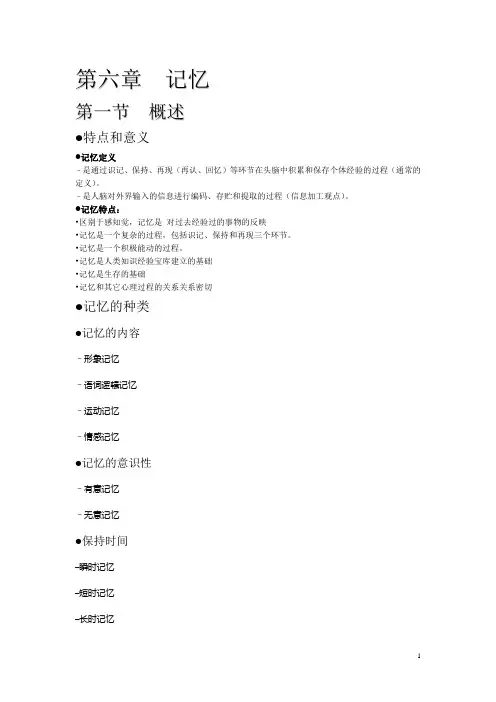
第六章记忆第一节概述●特点和意义●记忆定义–是通过识记、保持、再现(再认、回忆)等环节在头脑中积累和保存个体经验的过程(通常的定义)。
–是人脑对外界输入的信息进行编码、存贮和提取的过程(信息加工观点)。
●记忆特点:•区别于感知觉,记忆是对过去经验过的事物的反映•记忆是一个复杂的过程,包括识记、保持和再现三个环节。
•记忆是一个积极能动的过程。
•记忆是人类知识经验宝库建立的基础•记忆是生存的基础•记忆和其它心理过程的关系关系密切●记忆的种类●记忆的内容–形象记忆–语词逻辑记忆–运动记忆–情感记忆●记忆的意识性–有意记忆–无意记忆●保持时间–瞬时记忆–短时记忆–长时记忆•记忆方法–机械记忆–意义记忆•内隐记忆与外显记忆•抽象性–情景记忆–语义记忆●记忆的生理基础●定位说–海马是信息由短时记忆进入长时记忆的“开关”。
–颞叶–额叶●非定位说–记忆与神经突触的结构变化有关(突触假设)–记忆与神经元内部的化学变化有关(核糖核酸RNA)–记忆与神经系统的生化机制有关(乙酰胆碱)第二节记忆的经典研究●识记✓识记是记忆过程的开端,是保持的必要条件✓有意识记优于无意识记✓有意识记中,记忆的持久性与对记忆保持时间的要求有关✓意义识记优于机械识记●保持与遗忘●保持–经验在头脑中保持不是静止的,会发生质和量的变化。
–记忆恢复现象●影响遗忘进程的因素–时间因素(艾宾浩斯遗忘曲线)–识记材料的意义与作用–识记材料的性质–识记材料的数量–学习程度–识记材料的系列位置●遗忘的原因•干扰说•消退说•压抑说复习●及时复习●合理分配复习时间●反复阅读与试图回忆相结合●动员多种感官,采用多样化复习方法●活动有助于记忆●重现(再认与回忆)再认:确认过去经历过的事物。
●再认的速度与准确性主要取决于:–对旧事物识记的巩固程度–新旧事物的相似程度回忆:把以前经历过的事物在头脑中重新呈现并加以确认●根据是否有预定目的,可分为:–有意回忆–无意回忆●根据回忆是否需要中介,可分为;–直接回忆–间接回忆●追忆:–同时具有有意回忆和间接回忆的特点回忆策略与影响因素:–联想•接近律•相似律•对比律•因果律–定势与兴趣–与干扰作斗争(舌尖现象)第三节记忆的信息加工理论的研究●记忆的信息加工流程●感觉登记●图像记忆●Sperling部分报告法(partial report procedure)实验●刺激以感觉痕迹的形式登记下来,保持时间非常短暂,在0.25到2秒之间。
Chapter 6 Memory第6章记忆This chapter includes three modules: first, module 18 tells us how the memory works; second, module 19 introduces recalling in long-term memories; last, we will learn why we forgetting when our memory fails.MODULE 18 ENCODING, STORAGE AND RETRIEV AL OF MEMORYMemory is any system—human, animal, or machine—that encodes, stores, and retrieves information. The process of memory is encoding, storage and retrieval. Encoding is involving the modification of information to fit the preferred format for the memory system. Storage is involving the retention of encoded material over time. Retrieval is involving the location and recovery of information from memory.THE SENSORY REGISTERSScientific research on memory began with Ebbinghaus's experiments in the nineteenth century. Today the information-processing model of memory describes how information is encoded, organized, and stored in memory, and how it is retrieved from memory.THE SENSORY REGISTERSSensory registers are the entry points for raw information from all the senses. If we do not process this information further, it disappears.Visual and Auditory RegistersAs new visual information enters the registers, old information (the icon, or visual image) is "masked" almost immediately and disappears. Otherwise, the registers would overload as visual information piled up and became scrambled. Auditory information fades more slowly; the echo may last for several seconds.Initial ProcessingFrom the mass of incoming information, we select elements and hold them for further processing. In this process, called attention, we also give meaning to the information.SHORT-TERM MEMORYInformation that we attend to enters short-term memory (STM), also called primary memory and working memory. STM contains everything that we are consciously aware of at any instant. STM not only briefly stores information but also processes that information further.Capacity of STMSTM has its limits. Researches have found that STM can hold only as much information as can be repeated or rehearsed in 1.5 to 2 seconds, which is usually 5 to 10 separate bits of information. We can process more information by grouping it into larger meaningful units, a process called chunking.Encoding in STMInformation can be encoded for temporary storage in STM phonologically (according to the way it sounds), in visual form, or in terms of its meaning. Researchers conclude that STM has a greater capacity for material encoded visually than for information encoded phonologically.Retention and Retrieval in STMMaterial in STM disappears in 15 to 20 seconds unless it is rehearsed or practiced. According to decay theory, material is lost from STM simply because of the passage of time. Interference theory contends that interference from other information leads to forgetting from STM. Memory loss from STM is permanent. This prevents us from becoming overwhelmed with a mass of irrelevant, trivial, or unrelated data.Rote RehearsalThrough rote rehearsal, or maintenance rehearsal, we retain information in STM for a minute or two by repeating it over and over again. However, rote memorization does not promote long-term memory.Elaborative RehearsalElaborative rehearsal, or "the linking of new information in STM to familiar material stored in long-term memory," enables us to retain information for a longer time in STM. Through elaborative rehearsal, we process new data in a deeper and more meaningful way than through simple rote repetition.An accident or severe interference can make unrehearsed information disappear. Retrograde amnesia (the inability to recall events immediately preceding an accident or injury) is caused by an interruption in elaborative rehearsal.LONG-TERM MEMORYLong-term memory (LTM)is more or less permanent and stores everything we "know." Semantic memory is the portion of LTM that stores general facts and information in dictionary or encyclopedia form. Another facet of LTM, episodic memory, stores information rich with personal meaning.Encoding in LTMMost of the information in LTM seems to be encoded in terms of meaning. Through rehearsal, we extract the meaning of information and link it to as muchmaterial that is already in LTM as possible. The way in which we encode material for storage in LTM affects the ease with which we can retrieve it later on.Implicit MemoryImplicit memory refers to memories for information that either was not intentionally committed to LTM or is retrieved unintentionally from LTM. By contrast, explicit memory allows us to recall information that is intentionally committed to LTM and retrieved from LTM.Storage and Retrieval in LTMMost, if not all, of the information in LTM remains there more or less permanently, but we can''t always retrieve it when we need to, as the tip-of-the-tongue phenomenon shows.Especially disturbing events may cause us to repress memories or even to forget personal memories altogether (hysterical amnesia). Sometimes we "reconstruct" our memories for social or personal self-defense.Recognizing that past reactions and experiences affect our present memory, researchers developed the schema theory. A schema(plural: schemata) is a set of beliefs or expectations about something based on past experience, and it serves as a basis or standard for comparison with a new experience. Using schemata, we not only comprehend and interpret present circumstances but also streamline our retrieval processes. Retrieval is also aided by extensive cues and links with other material in LTM.BIOLOGICAL BASES OF MEMORYResearch has shown that some memories may be localized in certain portions of the brain; however, most memories are stored in various parts of the brain. One reason may be that several senses can contribute to one memory and might be stored in the brain''s centers for vision, speech, smell, and touch. Also, a recent finding shows that the basal forebrain may be involved in binding together information stored separately throughout the brain. The hippocampus is involved in transferring information from short-term to long-term memory.MODULE 19 RECALL LONG-TERM MEMORIESRetrieval cues are the “search terms” used to active a memory. It maybe a word, an emotion, or a sound.Flashbulb memoriesFlashbulb memories are a clear and vivid long-term memory of an especially meaningful and emotional event.Years after a dramatic or significant event occurs, people often have vivid memories of that event as well as the incidents surrounding it.These memories are known as flashbulb memories. According to the "now print" theory, the event triggers a mechanism in the brain that captures the memory, prints it, and stores it for a long time essentially unchanged. Recent research has challenged the assumptions that flashbulb memories are accurate and stable.Autobiographical MemoryAutobiographical memory refers to your recollection of events that happened in your life and when those events took place. People generally cannot remember events that occurred prior to age 2, and our earliest memories frequently concern events that significantly changed our lives or were particularly frightening.MODULE 20 FORGETTING: WHEN MEMORY FAILSSeveral reasons for ForgettingInformation in sensory and short-term memory appears to decay if it does not receive further processing. New information may "erase" old information in long-term memory. Proactive and retroactive interference may take place. Cue-dependent forgetting may occur when retrieval cues are inadequate. Some lapses in memory may be due to psychogenic amnesia, which is the forgetting of disturbing or shocking events and psychologists are divided about why this occurs.To the extent that information is apparently lost from LTM, researchers attribute the cause to interference from competing information. Interference may come from two directions: in retroactive interference, new information interferes with old information already in LTM; proactive interference refers to the process by which old information already in LTM interferes with new information. Interference affects both storage and retrieval of information.。